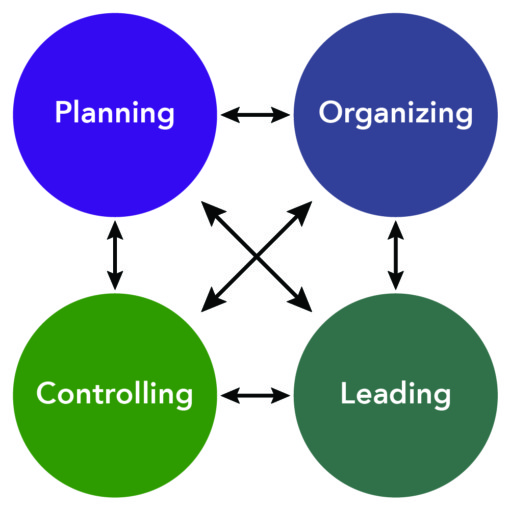Every exceptional leader carries out four leadership functions; they focus on the future while setting short and long-term goals. Leaders must allocate resources to ensure a realistic implementation once goals and action plans are created. Finally, leaders work to motivate their people to go above and beyond while tracking progress towards the goal. Leaders must plan, organize, lead, and control to drive results. Top, middle and lower-level leaders carry out these functions in various ways. Whether you are a leader or aspire to be one, understanding how these functions work is essential to your professional development. This article describes the four leadership functions and their importance while incorporating Ray Dalio’s leadership principles.


What Are the Four Leadership Functions?
The four leadership functions include planning, organizing, leading, and controlling.
The functions are the four most important tasks every leader must do to drive impact and profitability. These functions are consistent and applied across different sectors, regardless of your field. Leaders must first plan, then organize resources based on the plan, lead others to work toward the plan, evaluate how well the plan worked, and make necessary changes. It helps to think of the functions as a cycle, where each activity affects the others.
It’s worth noting that the leadership functions aren’t always linear. In other words, it won’t start with planning and moving forward until the end of the process. This is because it is impossible to anticipate every issue a business will face. As problems arise, leaders remain flexible and adjust their plans. In other words, the process restarts with planning if the leader discovers problems in any function. The most influential leaders emerge once all four functions are in place
Ray Dalio is a global macro investor and founder of Bridgewater Associates. Dalio grew his investment firm into the largest hedge fund in the world, with assets worth $160 billion. He spent his whole life gaining real-world experience and created 210 principles that help his employees do their best work. Dalio’s work philosophy aligns with the four leadership functions, which is why his firm is so successful.


Planning
Planning is keeping an eye on the future. The planning function involves establishing business goals and laying out a plan of action to accomplish them. During this phase, leaders set strategic direction and devise different ways to achieve the goals before selecting the best one. Typically, this involves looking at the current state of the business and any external factors to determine the best available resources to meet goals. Then, leaders set realistic timelines to reach their goals.


Dalio firmly believes planning comes before doing. Developing a plan is essential because it tells you what you must do to be successful. Dalio believes that too many people make the mistake of putting no time into design because they are too busy putting their plans into action. Dalio uses a five-step blueprint for process design which includes: setting clear goals, identifying problems, diagnosing problems and getting at the root causes, designing a plan, and pushing to completion.
Setting Clear Goals
Having a clear goal gives you a clear direction. It’s essential to think about what you desire most in life and create a list of goals that align with your values. In other words, your goals should reflect what you truly want. For example, accepting a new role as a chief financial officer would cause misalignment if you want more time with your family. It’s vital to never give up on a goal just because it seems impossible. You’d be surprised at what you can do if you had a clear idea of where you need to go. Finally, knowing how to deal with setbacks is just as important. Whether you get back up and try again or give up will depend on your attitude towards failure.
Identifying Problems
Dalio believes that problems help you discover new ways to improve your life. Accepting this fact is the first step to getting past it. So, be as specific as possible when thinking about your problems. Since different problems need different approaches, having a clear idea of the problem will help you come up with the best solution. Whatever you do, don’t allow the problem to go unaddressed; take immediate and decisive action to end it.
Diagnose Problems and Get At the Root Causes
To diagnose a problem well, you must look at it from every angle. Getting to the root cause means going deeper and hitting a painful chord. Often, our brains give us answers that make sense and feel good at the moment, but they keep us from taking action. Dalio claims that people who reach their full potential are willing to look at themselves objectively and figure out what’s holding them back.
Designing a Plan
Once you’ve diagnosed your problem and what’s causing it, it’s helpful to think of it as a set of outcomes. There are many ways to reach your goals; you need to find one that works for you. Dalio suggests creating a narrative and visualizing what needs to happen and in what order. You can improve your plan by turning the narrative into a list of steps with deadlines. Finally, keep the tasks, the narrative, and the goals separate. The tasks will tie the narratives and the goals together.
Pushing To Completion
The most important action in this final stage is execution. Dalio believes that executors are very organized because they prioritize tasks and ensure each task is completed correctly. They also set clear metrics to help them stick to the plan and reach their goals.
Organizing


Once the leader has set goals and created plans, the next step is to organize people and other resources to reach the goal. Organizing means getting things done according to specific plans and deadlines. Leaders must know what their teams are good at if they want to be successful. In other words, they need to know how much work each employee can handle and how much time they need to do their job well.
Dalio attributes his firm’s success to doing meaningful work, having meaningful relationships, and going after goals by being completely honest and open. He believes the best ideas follow a clear and repeatable process or an idea meritocracy. This decision-making system allows the group to select the best ideas. Three conditions must be met to promote a meritocracy:
Openness
Giving everyone a voice and listening to their ideas should be the first step in any solution. It’s important to get as many opinions out there as you can. The best ideas frequently appear in unexpected places.
Radical Transparency
Leaders often stray from conflict when it can lead to some of the greatest insights. Radical transparency gives people the space to disagree and express why they disagree. There are several ways to solve a problem; finding potential solutions without conflict is impossible. The best ideas form when people disagree thoughtfully. In fact, thoughtful disagreement is the only way to create a shared understanding of the problem.
Radical Truthfulness
Decisions made openly and honestly naturally lead to better decision-making. An effective way to drive buy-in is by helping the group understand why the decision was made.
Leading
Leading means getting people to work together for the good of the business by promoting a culture of teamwork across departments. Leaders must motivate their workers by showing them how their jobs fit into the bigger picture. Influential leaders give clear directions, inspire their employees to go above and beyond, communicate well, and coordinate activities strategically to reach their goals.


Dalio has shown that great leaders don’t always have the best ideas. Instead, they are the ones who make sure the best ideas win. The most effective leaders promote a culture of communication and debate – this is useful because it brings any missing pieces to the leaders’ attention. According to Dalio, leaders must do two things well:
Seek out the Best Answers
Even the best leaders will have trouble if they are focused on themselves. A good leader has just the right amount of doubt and is ready to deal with it by exploring with an open mind. In line with this idea, Dalio places tremendous value on asking questions. He thinks that questions help leaders make effective decisions.
Bring Others Along the Discovery Process
When employees have a thoughtful discussion, it shows that everyone is involved in the process. They try to figure out what’s going on by giving different points of view. This method helps get to the bottom of problems, letting people know the truth and refining problems into solutions as a group.
Controlling
Leaders must ensure that they coordinate day-to-day tasks for the best results. To control, you have to lead your workers toward the goals and keep track of their progress along the way. In the same way, control lets leaders use business resources effectively to help the business reach its goals. The controlling function helps determine how actual performance compares to the set standards, what caused the differences, and how to fix them. Based on the problems found, this process helps make better plans for the future. Controlling brings the leadership function process to a close and helps plan for the next cycle.


Dalio believes that learning is the product of a continuous real-time feedback loop in which we make decisions, assess their outcome, and improve our understanding. Remaining open-minded allows the feedback loop process to work more efficiently. The more open-minded you are, the less likely you are to fool yourself and the more likely that others will give you honest feedback. If they are trustworthy people, you will learn a lot from them. But you won’t learn if you’re not totally honest with yourself, and don’t put yourself out there.
Conclusion
Effective leaders know how to create a plan, organize the necessary resources, motivate their people, and track progress toward the goals. Leaders subconsciously complete these four leadership functions, and the immediate impact is felt throughout the business. There’s alignment across departments; specific tasks are thoughtfully assigned and ultimately contribute to strategic goals. There’s an organizational flow; employees know what they need to do and why they need to do it. Employees are inspired and motivated to perform beyond expectations. Lastly, leaders coordinate activities, track progress, and make necessary adjustments.
Bianca Cardenas, M.S., Ph.D., is a Fellow in Executive Assessment and Consulting with Leadership Worth Following. Dr. Bianca Cardenas empowers leaders to transcend competition by helping them unlock their people's potential.






